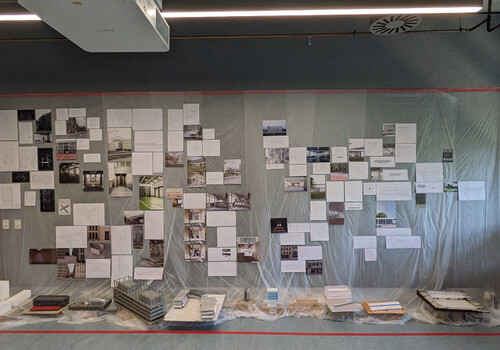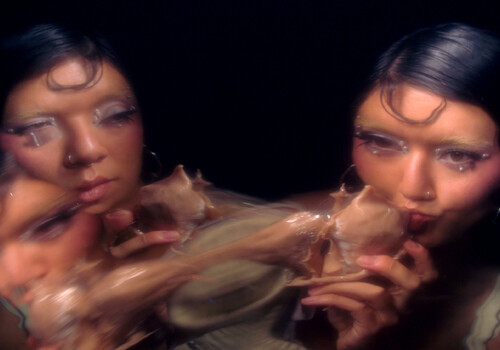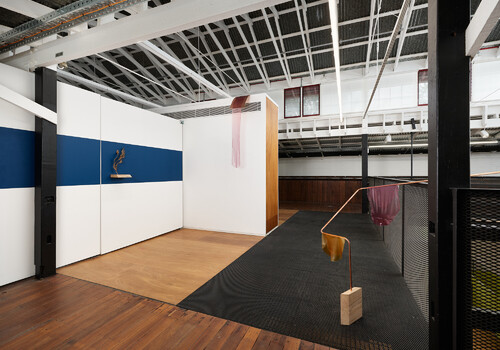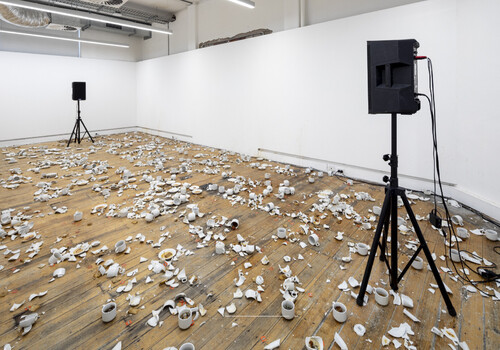Painting, Queensland College of Art
By Tara Gouttman
Tara Gouttman is an emerging arts worker and writer in Meanjin/Brisbane. She is a recent honours graduate in art history from the University of Queensland.
Grad shows project a sense of cohesion amid their inherent chaos, arising from the multitude of participating artists and the varied nature of their showcases. On opening night, the Queensland College of Art’s painting studio is buzzing with alumni, family, and guests eager to view the 30+ graduating students. Many of the artists explore the cohesion and chaos that come with grad shows by focusing on non-linear narratives that involve the everyday, collective, and personal.

Anna Weston, Snakes and Union Approved EWP’s, 2024, Oil on board. QCA, Brisbane. Photo: courtesy of Griffith University.
Anna Weston’s Snakes and Union Approved EWP’s (2024) embraces the melodramatic chaos of the everyday. The work is comparable to a Where’s Wally? book, sharing a dream-like similarity. The mundane of community living is recognisable amidst the chaos; we see an Auspost worker and a pampered dog being pushed in a stroller. Also observable is a dead pigeon and the overflowing hose that gathers a curious crowd, all watched by a shadowy, peeping figure. The work encapsulates the complex experiences of coexistence—where everyday moments of joy and unease overlap in the narratives of community. The dead birds, creepy men, and pampered dogs of our suburbs are depicted with a lightheartedness that contrasts with what lies beyond the apartment complexes of today’s cynical dystopia.

Anna Weston, Installation view of The Complex Apartment, 2024. Oil on board. QCA, Brisbane. Photo: courtesy of Griffith University.

Mia Gunton, Installation view of Starved and Salacious, 2024. Acrylic on canvas and stretched fabric. QCA, Brisbane. Photo: courtesy of Griffith University.
Shared moments of communal time are also referenced in Mia Gunton’s self-portraiture series Starved and Salacious (2024). The series of eight paintings explores how food is used in the collective experience of cinema to convey narratives of sexuality. The Fig is Finished (2024) recalls a scene from Ken Russell’s 1969 film Women In Love where the main character calls attention to his female dining companion cutting open a fig, promptly alluding to the fruit as a metaphor for female sexuality. Secretive and in turned, if exposed the fig will split and rupture. Women are taught that their fig must be handled carefully to prevent rot. Gunton’s work replaces the film’s communal voyeuristic gaze with one of decisiveness, challenging double standards by looking her audience directly in the eye, inviting participation in a different kind of communal time in which she finishes the fig.

Jorge Mariño Brito, Installation view of 9 to 5: Capturing Life’s Tender Moments, (left to right:) Has escuchado a Dolly, 9 a 5 (déjame sonar), Something fishy (Lo dijo Dolly), 2024. Oil on canvas. QCA, Brisbane. Photo: courtesy of Griffith University.
Finally, there is Jorge Marino Brito’s 9 to 5 (2024), a series laden with ambiguous narratives that feel inherently personal due to the fragmentary handling of paint. Each work resurrects a moment captured in found photographs, evident in the suggested space of Has escuchado a Dolly? (2024) The hazy landscape behind the frontal, ghostlike figures creates an impression of fading recollections—figures and landscape both emerge and recede into memory. Liminal space blurs the boundary between reality and nostalgia. When we recognise this, along with the artist’s self-identified investigation of gender, sexuality and queer identity, we begin to view the work as suspended memories brought to consciousness on canvas.
Although grad shows are chaotic, defined by their sheer volume and varied subject matter, the narratives within these works embrace a disjointed storytelling that brings every day, personal and collective experiences into focus. The QCA painting department leans into these disparate threads and recognises that true cohesion lies in our complexities.
Tara Gouttman is an emerging arts worker and writer in Meanjin/Brisbane. She is a recent honours graduate in art history from the University of Queensland.









































